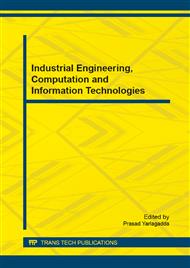[1]
S. Goferman, L. Zelnik-Manor, and A. Tal. Context-aware saliency detection. In CVPR, (2010).
DOI: 10.1109/cvpr.2010.5539929
Google Scholar
[2]
D. Klein and S. Frintrop. Center-surround divergence of feature statistics for salient object detection. In ICCV, (2011).
DOI: 10.1109/iccv.2011.6126499
Google Scholar
[3]
L. Itti. Automatic foveation for video compression using a neurobiological model of visual attention. IEEE TIP, (2004).
DOI: 10.1109/tip.2004.834657
Google Scholar
[4]
T. Chen, M. Cheng, P. Tan, A. Shamir, and S. Hu. Sketch2photo: Internet image montage. ACM Trans. on Graphics, (2009).
DOI: 10.1145/1618452.1618470
Google Scholar
[5]
L. Grady, M. Jolly, and A. Seitz. Segmenation from a box. In ICCV, (2011).
Google Scholar
[6]
V. Lempitsky, P. Kohli, C. Rother, and T. Sharp. Image segmentation with a bounding box prior. In ICCV, (2009).
DOI: 10.1109/iccv.2009.5459262
Google Scholar
[7]
L. Itti, C. Koch, and E. Niebur. A model of saliency-based visual attention for rapid scene analysis. IEEE PAMI, (1998).
DOI: 10.1109/34.730558
Google Scholar
[8]
N. Bruce and J. Tsotsos. Saliency based on information maximization. NIPS, (2006).
Google Scholar
[9]
X. Hou and L. Zhang. Saliency detection: A spectral residual approach. In CVPR, (2007).
Google Scholar
[10]
Y. Zhai and M. Shah. Visual attention detection in video sequences using spatiotemporal cues. InACM Multimedia, pages 815–824, (2006).
DOI: 10.1145/1180639.1180824
Google Scholar
[11]
M. M. Cheng, G. X. Zhang, N. J. Mitra, X. Huang, and S. M. Hu. Global contrast based salient region detection. In CVPR, (2011).
DOI: 10.1109/cvpr.2011.5995344
Google Scholar
[12]
R. Achanta, K. Smith, A. Lucchi, P. Fua, and S. Susstrunk. Slicsuperpixels. Technical report, EPFL, Tech. Rep. 149300, (2010).
Google Scholar
[13]
J. Wright, A.Y. Yang, A. Ganesh, S.S. Sastry, and Y. Ma. Robust Face Recognition via Sparse Representation. IEEE TPAMI, 31(2): 210–227, (2009).
DOI: 10.1109/tpami.2008.79
Google Scholar
[14]
Yan Q, Xu L, Shi J, et al. Hierarchical saliency detection[C]/Computer Vision and Pattern Recognition (CVPR), 2013 IEEE Conference on. IEEE, 2013: 1155-1162.
DOI: 10.1109/cvpr.2013.153
Google Scholar
[15]
R. Achanta, S. Hemami, F. Estrada, and S. Susstrunk. Frequency tuned salient region detection. In CVPR, (2009).
DOI: 10.1109/cvpr.2009.5206596
Google Scholar
[16]
S. Goferman, L. Zelnik-Manor, and A. Tal. Context-aware saliency detection. In CVPR, (2010).
DOI: 10.1109/cvpr.2010.5539929
Google Scholar


